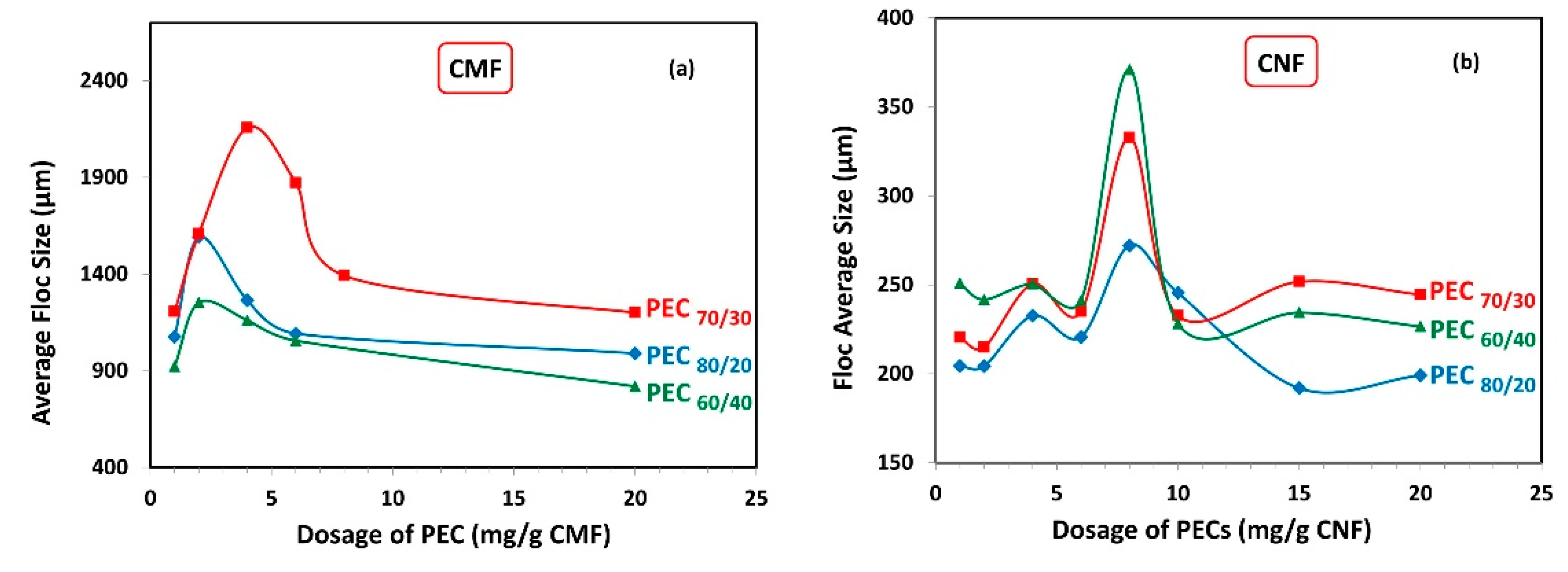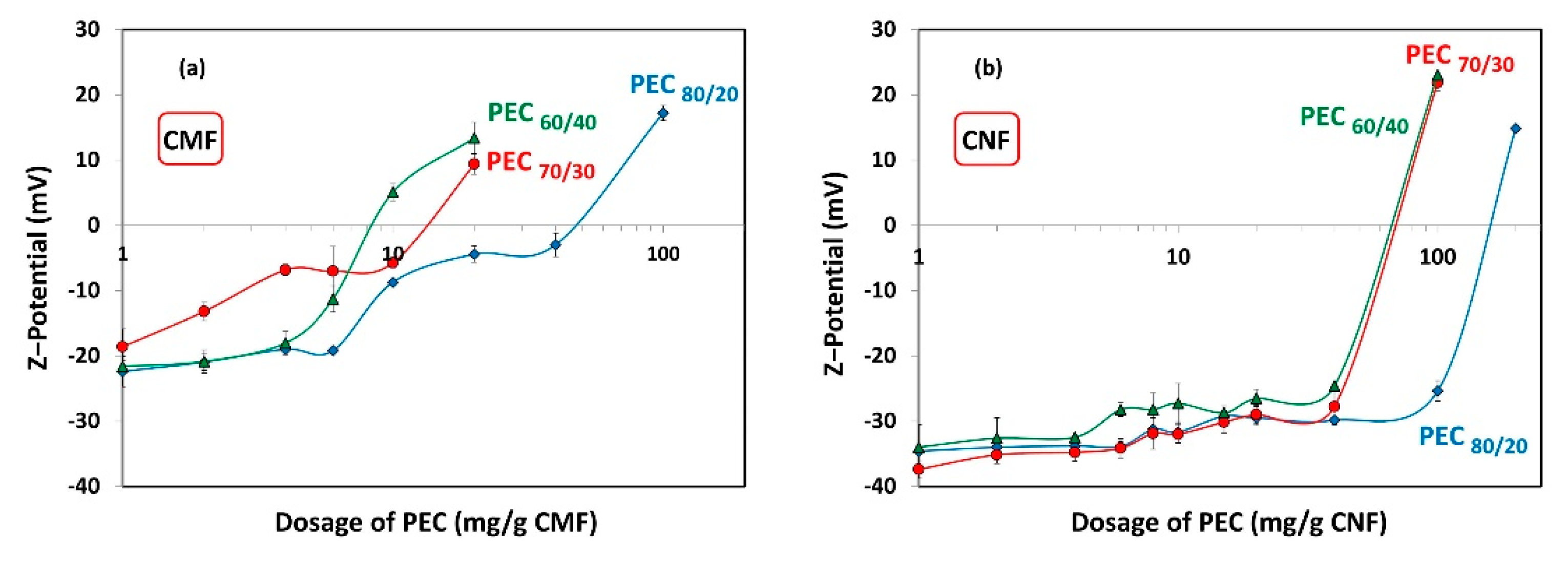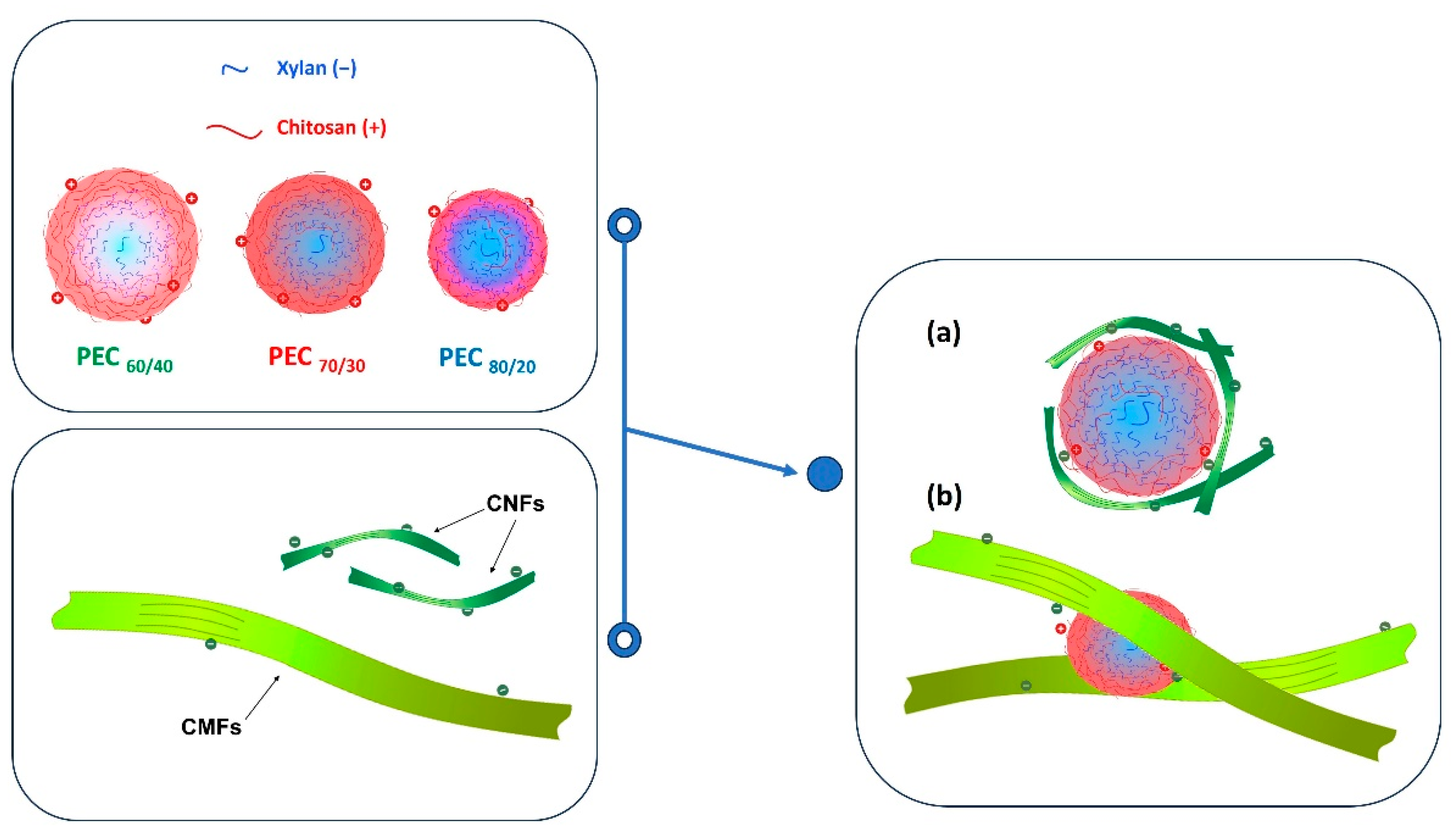Flocculation of Cellulose Microfiber and Nanofiber Induced by Chitosan–Xylan Complexes
Abstract
:1. Introduction
2. Materials and Methods
2.1. Materials
2.2. Preparation and Characterization of Polyelectrolyte Complexes (PECs)
2.3. Preparation of CMFs and CNFs
2.4. Individual Rheological Behavior of Polyelectrolytes and PECs
2.4.1. Determination of the Critical Concentration (c*) and the Intrinsic Viscosity [η]
2.4.2. Rheological Parameters
2.5. Flocculation of PEC-CMF and PEC-CNF Systems at Dynamic Conditions
Viscosity
2.6. Flocculation of PEC-CMF and PEC-CNF Systems under Static Conditions
2.6.1. Gel Point
2.6.2. Average Flocs Size
2.6.3. Zeta Potential
3. Results
3.1. Individual Rheological Behavior of Polyelectrolytes and PECs
3.1.1. Determination of Critical Concentration (c*) and the Intrinsic Viscosity [η]
3.1.2. Rheological Parameters
3.2. Flocculation of PEC-CMF and PEC-CNF Systems under Dynamic Conditions
3.3. Flocculation of PEC-CMF and PEC-CNF Systems at Static Conditions
Gel Point, Average Floc Size, and ζ-Potential
4. Conclusions
Supplementary Materials
Author Contributions
Funding
Institutional Review Board Statement
Informed Consent Statement
Data Availability Statement
Acknowledgments
Conflicts of Interest
References
- Petzold, G.; Schwarz, S. Polyelectrolyte complexes in flocculation applications. Adv. Polym. Sci. 2014, 256, 25–66. [Google Scholar] [CrossRef]
- Hu, F.; Zeng, J.; Cheng, Z.; Wang, X.; Wang, B.; Zeng, Z.; Chen, K. Cellulose nanofibrils (CNFs) produced by different mechanical methods to improve mechanical properties of recycled paper. Carbohydr. Polym. 2020, 254, 117474. [Google Scholar] [CrossRef] [PubMed]
- Dufresne, A. Nanocellulose: A new ageless bionanomaterial. Mater. Today 2013, 16, 220–227. [Google Scholar] [CrossRef]
- Jaffar, S.S.; Saallah, S.; Misson, M.; Siddiquee, S.; Roslan, J.; Saalah, S.; Lenggoro, W. Recent Development and Environmental Applications of Nanocellulose-Based Membranes. Membranes 2022, 12, 287. [Google Scholar] [CrossRef] [PubMed]
- Zhang, K.; Ketterle, L.; Järvinen, T.; Hong, S.; Liimatainen, H. Conductive hybrid filaments of carbon nanotubes, chitin nanocrystals and cellulose nanofibers formed by interfacial nanoparticle complexation. Mater. Des. 2020, 191, 108594. [Google Scholar] [CrossRef]
- Curvello, R.; Raghuwanshi, V.S.; Garnier, G. Engineering nanocellulose hydrogels for biomedical applications. Adv. Colloid Interface Sci. 2019, 267, 47–61. [Google Scholar] [CrossRef]
- Siró, I.; Plackett, D. Microfibrillated cellulose and new nanocomposite materials: A review. Cellulose 2010, 17, 459–494. [Google Scholar] [CrossRef]
- Korhonen, M.H.J.; Sorvari, A.; Saarinen, T.; Seppälä, J.; Laine, J. Anionic Polymer Deflocculants. Bioresources 2014, 9. [Google Scholar]
- Bhardwaj, N.K.; Kumar, S.; Bajpai, P.K. Effect of zeta potential on retention and drainage of secondary fibres. Colloids Surfaces A: Physicochem. Eng. Asp. 2005, 260, 245–250. [Google Scholar] [CrossRef]
- Veronica, P.; Eng, R.B. Nanocellulose-Polyelectrolyte Complexes. Doctoral Dissertation, Monash University, Melbourne, Australia, 2016. [Google Scholar]
- Blanco, A.; Fuente, E.; Negro, C.; Tijero, J. Flocculation Monitoring: Focused Beam Reflectance Measurement as a Measurement Tool. Can. J. Chem. Eng. 2008, 80, 1–7. [Google Scholar] [CrossRef]
- Hubbe, M.A.; Tayeb, P.; Joyce, M.; Tyagi, P.; Kehoe, M.; Dimic-Misic, K.; Pal, L. Nanocellulose Rheology. Bioresources 2017, 12, 9556–9661. [Google Scholar] [CrossRef]
- Yin, Y.J.; Yao, K.D.; Cheng, G.X.; Ma, J.B. Properties of polyelectrolyte complex films of chitosan and gelatin. Polym Int. 1999, 48, 429–432. [Google Scholar] [CrossRef]
- Li, J.; van Ewijk, G.; van Dijken, D.J.; van der Gucht, J.; de Vos, W.M. Single-Step Application of Polyelectrolyte Complex Films as Oxygen Barrier Coatings. ACS Appl. Mater. Interfaces 2021, 13, 21844–21853. [Google Scholar] [CrossRef] [PubMed]
- Karaaslan, A.M.; Tshabalala, M.A.; Buschle-Diller, G. Hemicellulose-Chitosan Gels. BioResources5 2010, 5. [Google Scholar]
- Yu, X.; Somasundaran, P. Enhanced flocculation with double flocculants. Colloids Surf. A Physicochem. Eng. Asp. 1993, 81, 17–23. [Google Scholar] [CrossRef]
- Gärdlund, L.; Forsström, J.; Andreasson, B.; Wågberg, L. Influence of polyelectrolyte complexes on the strength properties of papers from unbleached kraft pulps with different yields. Nord. Pulp Pap. Res. J. 2005, 20, 36–42. [Google Scholar] [CrossRef]
- Bastida, G.A.; Zanuttini, M.A.; Tarrés, Q.; Fiol, N.; Delgado-Aguilar, M.; Galván, M.V. Innovative system based on natural polyelectrolyte complex and cellulose micro/nanofibers to improve drainability and properties of recycled paper. Cellulose 2023, 30, 5895–5910. [Google Scholar] [CrossRef]
- Raj, P.; Batchelor, W.; Blanco, A.; de la Fuente, E.; Negro, C.; Garnier, G. Effect of polyelectrolyte morphology and adsorption on the mechanism of nanocellulose flocculation. J. Colloid Interface Sci. 2016, 481, 158–167. [Google Scholar] [CrossRef]
- Nyström, R.S.; Rosenholm, J.B.; Nurmi, K. Flocculation of Semidilute Calcite Dispersions Induced by Anionic Sodium Polyacrylate−Cationic Starch Complexes. Langmuir 2003, 19, 3981–3986. [Google Scholar] [CrossRef]
- Saarikoski, E.; Saarinen, T.; Salmela, J.; Seppälä, J. Flocculated flow of microfibrillated cellulose water suspensions: An imaging approach for characterisation of rheological behaviour. Cellulose 2012, 19, 647–659. [Google Scholar] [CrossRef]
- Sim, K.; Lee, J.; Lee, H.; Youn, H.J. Flocculation behavior of cellulose nanofibrils under different salt conditions and its impact on network strength and dewatering ability. Cellulose 2015, 22, 3689–3700. [Google Scholar] [CrossRef]
- Gorbacheva, S.N.; Ilyin, S.O. Morphology and Rheology of Heavy Crude Oil/Water Emulsions Stabilized by Microfibrillated Cellulose. Energy Fuels 2021, 35, 6527–6540. [Google Scholar] [CrossRef]
- Solomon, M.J.; Spicer, P.T. Microstructural regimes of colloidal rod suspensions, gels, and glasses. Soft Matter 2010, 6, 1391–1400. [Google Scholar] [CrossRef]
- Olson, J.A.; Ruth, T.J.; Kerekes, R.J. Characterizing the Mobility of Papermaking Fibres During Sedimentation. In The Science of Papermaking: Transactions of the 12th Fundamental Research Symposium, Oxford, 2001; FRC: Manchester, UK, 2018; pp. 225–254. [Google Scholar] [CrossRef]
- Varanasi, S.; He, R.; Batchelor, W. Estimation of cellulose nanofibre aspect ratio from measurements of fibre suspension gel point. Cellulose 2013, 20, 1885–1896. [Google Scholar] [CrossRef]
- Bastida, G.A.; Schnell, C.N.; Mocchiutti, P.; Solier, Y.N.; Inalbon, M.C.; Zanuttini, M.; Galván, M.V. Effect of Oxalic Acid Concentration and Different Mechanical Pre-Treatments on the Production of Cellulose Micro/Nanofibers. Nanomaterials 2022, 12, 2908. [Google Scholar] [CrossRef]
- Mewis, J.; Wagner, N.J. Colloidal_Suspension_Rheology; Cambridge University Press: Cambridge, UK, 2011. [Google Scholar]
- Sanchez-Salvador, J.L.; Monte, M.C.; Batchelor, W.; Garnier, G.; Negro, C.; Blanco, A. Characterizing highly fibrillated nanocellulose by modifying the gel point methodology. Carbohydr. Polym. 2019, 227, 115340. [Google Scholar] [CrossRef] [PubMed]
- Korhonen, M.; Laine, J. Flocculation and retention of fillers with nanocelluloses. Nord. Pulp Pap. Res. J. 2014, 29, 119–128. [Google Scholar] [CrossRef]
- Raj, P.; Varanasi, S.; Batchelor, W.; Garnier, G. Effect of cationic polyacrylamide on the processing and properties of nanocellulose films. J. Colloid Interface Sci. 2015, 447, 113–119. [Google Scholar] [CrossRef]
- Raj, P.; Blanco, A.; de la Fuente, E.; Batchelor, W.; Negro, C.; Garnier, G. Microfibrilated cellulose as a model for soft colloid flocculation with polyelectrolytes. Colloids Surfaces A Physicochem. Eng. Asp. 2017, 516, 325–335. [Google Scholar] [CrossRef]
- Mocchiutti, P.; Schnell, C.N.; Rossi, G.D.; Peresin, M.S.; Zanuttini, M.A.; Galván, M.V. Cationic and anionic polyelectrolyte complexes of xylan and chitosan. Interaction with lignocellulosic surfaces. Carbohydr. Polym. 2016, 150, 89–98. [Google Scholar] [CrossRef]
- Jiang, X.; Chen, L.; Zhong, W. A new linear potentiometric titration method for the determination of deacetylation degree of chitosan. Carbohydr. Polym. 2003, 54, 457–463. [Google Scholar] [CrossRef]
- Schnell, C.N.; Galván, M.V.; Peresin, M.S.; Inalbon, M.C.; Vartiainen, J.; Zanuttini, M.A.; Mocchiutti, P. Films from xylan/chitosan complexes: Preparation and characterization. Cellulose 2017, 24, 4393–4403. [Google Scholar] [CrossRef]
- Solier, Y.N.; Mocchiutti, P.; Cabrera, M.N.; Saparrat, M.C.N.; Zanuttini, M.; Inalbon, M.C. Alkali-peroxide treatment of sugar cane bagasse. Effect of chemical charges on the efficiency of xylan isolation and susceptibility of bagasse to saccharification. Biomass Convers. Biorefinery 2020, 12, 567–576. [Google Scholar] [CrossRef]
- Solier, Y.N.; Schnell, C.N.; Cabrera, M.N.; Zanuttini, M.; Inalbon, M.C. Alkali-peroxide extraction of xylan from sugar cane bagasse. Characteristics and film forming capacity. Ind. Crop. Prod. 2020, 145, 112056. [Google Scholar] [CrossRef]
- Cegnar, M.; Ker, J. Self-assembled Polyelectrolyte Nanocomplexes of Alginate, Chitosan and Ovalbumin. Acta Chim. Slov. 2010, 57, 431–441. [Google Scholar] [PubMed]
- Albornoz-Palma, G.; Betancourt, F.; Mendonça, R.T.; Chinga-Carrasco, G.; Pereira, M. Relationship between rheological and morphological characteristics of cellulose nanofibrils in dilute dispersions. Carbohydr. Polym. 2019, 230, 115588. [Google Scholar] [CrossRef] [PubMed]
- Williams, P.A.; Phillips, G.O. Chapter 1—Introduction to food hydrocolloids. In Handbook of Hydrocolloids, 3rd ed.; Phillips, G.O., Williams, P.A., Eds.; Woodhead Publishing: Sawston, UK, 2021; pp. 3–26. [Google Scholar] [CrossRef]
- Abbastabar, B.; Azizi, M.H.; Adnani, A.; Abbasi, S. Determining and modeling rheological characteristics of quince seed gum. Food Hydrocoll. 2015, 43, 259–264. [Google Scholar] [CrossRef]
- Kujawa, P.; Audibert-Hayet, A.; Selb, J.; Candau, F. Effect of Ionic Strength on the Rheological Properties of Multisticker Associative Polyelectrolytes. Macromolecules 2005, 39, 384–392. [Google Scholar] [CrossRef]
- Hwang, J.K.; Shin, H.H. Rheological properties of chitosan solutions. Korea-Aust. Rheol. J. 2000, 12, 175–179. [Google Scholar]
- Fuoss, R.M. Polyelectrolytes. Discuss. Faraday Soc. 1951, 11, 125–134. [Google Scholar] [CrossRef]
- Tingaut, P.; Zimmermann, T.; Sèbe, G. Cellulose nanocrystals and microfibrillated cellulose as building blocks for the design of hierarchical functional materials. J. Mater. Chem. 2012, 22, 20105–20111. [Google Scholar] [CrossRef]
- Gartner, C.; López, B.L. Stiffness of chitosan in solution through intrinsic viscosity measurements. Rev. Fac. Ing. Univ. Antioq. N. 2010, 53, 20–29. [Google Scholar]
- Da Silva, J.C.; De Oliveira, R.C.; Neto, A.D.S.; Pimentel, V.C.; Santos, A.D.A.D. Extraction, Addition and Characterization of Hemicelluloses from Corn Cobs to Development of Paper Properties. Procedia Mater. Sci. 2015, 8, 793–801. [Google Scholar] [CrossRef]
- Zhang, L.-M.; Huang, S.-J. Viscosity properties of homogeneous polyelectrolyte complex solutions from sodium carboxymethyl cellulose and poly(acrylamide-co-dimethyldiallylammonium chloride). Polym. Int. 2000, 49, 528–532. [Google Scholar] [CrossRef]
- Schramm, L.L. Emulsions, Foams, and Suspensions. In Emulsions, Foams, and Suspensions; Wiley-VCH Verlag GmbH & Co. KGaA: Weinheim, Germany, 2006; pp. I–XV. [Google Scholar] [CrossRef]
- Mazeau, K.; Moine, C.; Krausz, P.; Gloaguen, V. Conformational analysis of xylan chains. Carbohydr. Res. 2005, 340, 2752–2760. [Google Scholar] [CrossRef] [PubMed]
- Schatz, C.; Viton, C.; Delair, T.; Pichot, C.; Domard, A. Typical Physicochemical Behaviors of Chitosan in Aqueous Solution. Biomacromolecules 2003, 4, 641–648. [Google Scholar] [CrossRef] [PubMed]
- Dautzenberg, H.; Jaeger, W. Effect of charge density on the formation and salt stability of polyelectrolyte complexes. Macromol. Chem. Phys. 2002, 203, 2095–2102. [Google Scholar] [CrossRef]
- Wyatt, N.B.; Liberatore, M.W. Rheology and viscosity scaling of the polyelectrolyte xanthan gum. J. Appl. Polym. Sci. 2009, 114, 4076–4084. [Google Scholar] [CrossRef]
- Rajput, I.B.; Tareen, F.K.; Khan, A.U.; Ahmed, N.; Khan, M.F.A.; Shah, K.U.; Rahdar, A.; Díez-Pascual, A.M. Fabrication and in vitro evaluation of chitosan-gelatin based aceclofenac loaded scaffold. Int. J. Biol. Macromol. 2023, 224, 223–232. [Google Scholar] [CrossRef]
- Ashok, R.P.R.; Thomas, M.S.; Varughese, S. Multi-region to single region shear thinning transitions in drying PEDOT:PSS dispersions: Contributions from charge density fluctuations. Soft Matter 2015, 11, 8441–8451. [Google Scholar] [CrossRef]
- Lauri, J.; Haavisto, S.; Salmela, J.; Miettinen, A.; Fabritius, T.; Koponen, A.I. Online measurement of floc size, viscosity, and consistency of cellulose microfibril suspensions with optical coherence tomography. Cellulose 2021, 28, 3373–3387. [Google Scholar] [CrossRef]








| Nanofibrillation Yield (%) | Diameter of CMF Fraction Determined by SEM (nm) | CNF Fraction Determined by TEM | |||
|---|---|---|---|---|---|
| Average Diameter (nm) | Average Length (nm) | Average Aspect Ratio (Length/Diameter) | |||
| CMF | 12 ± 1 | 190 ± 40 | 13 ± 4 | 1200 ± 300 | 92.3 |
| CNF | 54.3 ± 0.3 | 190 ± 95 | 12 ± 4 | 800 ± 200 | 66.7 |
| Sample | Critical Concentration (c*) (wt %) | Intrinsic Viscosity [η] (mL/g) | ζ-Potential (mV) (1) | Average Size (nm) (2) | PDI (2) |
|---|---|---|---|---|---|
| Ch | 0.04 | 7610.0 | +37 ± 2 | --- | --- |
| Xyl | >0.6 | 54.4 | −10 ± 2 | --- | --- |
| PEC60/40 | 0.10 | 1299.2 | +31 ± 1 | 565 ± 10 | 0.28 ± 0.03 |
| PEC70/30 | 0.25 | 690.2 | +29.3 ± 0.5 | 530 ± 5 | 0.27 ± 0.02 |
| PEC80/20 | 0.30 | 205.3 | +18.3 ± 0.8 | 400 ± 5 | 0.23 ± 0.02 |
| CMF | 0.03 (3) | 367.6 (3) | −27 ± 5 (4) | 200 ± 30 (4) | 0.61 ± 0.03 (4) |
| CNF | 0.07 (3) | 145.5 (3) | −32 ± 4 (4) | 80 ± 15 (4) | 0.47 ± 0.01 (4) |
| Samples | K (1/(mPa·s)) | n | R2 |
|---|---|---|---|
| Xyl | 40.3 | 0.841 | 0.9731 |
| Ch | 181.1 | 0.915 | 0.9752 |
| PEC 60/40 | 89.5 | 0.808 | 0.9789 |
| PEC 70/30 | 77.2 | 0.779 | 0.9853 |
| PEC 80/20 | 43.9 | 0.841 | 0.9955 |
Disclaimer/Publisher’s Note: The statements, opinions and data contained in all publications are solely those of the individual author(s) and contributor(s) and not of MDPI and/or the editor(s). MDPI and/or the editor(s) disclaim responsibility for any injury to people or property resulting from any ideas, methods, instructions or products referred to in the content. |
© 2023 by the authors. Licensee MDPI, Basel, Switzerland. This article is an open access article distributed under the terms and conditions of the Creative Commons Attribution (CC BY) license (https://creativecommons.org/licenses/by/4.0/).
Share and Cite
Bastida, G.A.; Tarrés, Q.; Aguado, R.; Delgado-Aguilar, M.; Zanuttini, M.Á.; Galván, M.V. Flocculation of Cellulose Microfiber and Nanofiber Induced by Chitosan–Xylan Complexes. Nanomaterials 2023, 13, 2420. https://doi.org/10.3390/nano13172420
Bastida GA, Tarrés Q, Aguado R, Delgado-Aguilar M, Zanuttini MÁ, Galván MV. Flocculation of Cellulose Microfiber and Nanofiber Induced by Chitosan–Xylan Complexes. Nanomaterials. 2023; 13(17):2420. https://doi.org/10.3390/nano13172420
Chicago/Turabian StyleBastida, Gabriela Adriana, Quim Tarrés, Roberto Aguado, Marc Delgado-Aguilar, Miguel Ángel Zanuttini, and María Verónica Galván. 2023. "Flocculation of Cellulose Microfiber and Nanofiber Induced by Chitosan–Xylan Complexes" Nanomaterials 13, no. 17: 2420. https://doi.org/10.3390/nano13172420





